Sensing-Assisted Communication for mmWave Networks: A Review of Techniques, Applications, and Future Directions
Abstract
1. Introduction
- A comprehensive review is conducted focusing specifically on SAC for mmWave and Sub-THz wireless systems, clearly distinguishing it from general ISAC and emphasizing its role in enhancing beamforming, reliability, and adaptability.
- A structured taxonomy of SAC techniques is introduced, organized by sensing modality, prediction algorithm, and deployment integration, to serve as a foundation for comparative evaluation.
- Real-world applications are highlighted and discussed where SAC plays a transformative role, such as in Vehicle-to-Everything (V2X) communication, UAV connectivity, and high-frequency Wireless Local Area Networks (WLANs) with particular emphasis on predictive beamforming and training overhead reduction [5,6,7].
2. Radar as a Foundational Sensing Function
2.1. Radar Architectures
- Phased-Array Radar: This architecture employs electronically steered antenna arrays, in which each element is driven with programmable phase shifts to form directional beams without requiring mechanical movement [17]. Phased-array systems enable agile beam steering, high array gain, and support for multi-beam operation. These properties are especially advantageous in ISAC applications operating at mmWave and Sub-THz frequencies, where rapid spatial adaptation is critical [18].
- Frequency-Modulated Continuous-Wave (FMCW) Radar: FMCW radar transmits a continuously swept-frequency waveform (chirp) and extracts target range and velocity by analyzing the frequency difference between transmitted and received signals [19]. The low peak power and high resolution of FMCW systems make them well-suited for short-range sensing and compact ISAC transceiver implementations.
- MIMO Radar: In MIMO radar systems, orthogonal waveforms are transmitted from multiple antennas, and received signals are jointly processed to synthesize a large virtual aperture [20]. This architecture significantly enhances angular resolution and is inherently compatible with MIMO communication platforms, thereby facilitating hardware reuse and co-design for ISAC [2,21].
- Passive Radar: Passive radar systems exploit ambient RF signals—such as cellular, television, or Wi-Fi transmissions—as illuminators of opportunity [22]. Although such systems do not have control over the transmitted waveform, they offer spectral efficiency, low implementation cost, and reduced probability of intercept. These features make passive radar particularly attractive for covert or interference-sensitive ISAC scenarios in dense wireless environments [23].
- Pulse-Doppler Radar: This classical radar configuration transmits periodic pulses and applies matched filtering combined with Doppler analysis to simultaneously extract range and velocity information [17]. Widely used for moving target indication and clutter suppression, pulse-Doppler radar can be adapted for coexistence with communication signals in dual-function ISAC transceivers [24,25].
2.2. Radar Sensing Topologies
- Monostatic Radar: In monostatic radar, the transmitter and receiver are co-located, often sharing a common antenna through a circulator or duplexer. This geometry simplifies transceiver design and synchronization, while providing strong target echoes and high Signal-to-Noise ratios (SNRs), particularly at short to medium ranges [17]. Monostatic systems are widely adopted in automotive, aerospace, and fixed-node applications. Within ISAC, this geometry enables a single transceiver to perform both communication and environmental sensing using the same waveform and hardware chain [2].
- Quasi-Monostatic Radar: This configuration serves as an intermediate case in which transmit and receive antennas are spatially separated by a short distance, typically within the same device enclosure. While maintaining much of the synchronization and calibration simplicity of monostatic systems, quasi-monostatic radar offers improved angular diversity and enhanced spatial resolution. Recent ISAC studies have employed this setup in benchmark experiments to assess Angle-of-Arrival (AoA) estimation and near-field beam prediction [26].
- Bistatic Radar: Bistatic radar employs a transmitter and receiver at geographically distinct locations, separated by a considerable distance, ranging from tens to hundreds of meters. This arrangement enhances spatial diversity and provides robustness to multipath and Non-Line-of-Sight (NLoS) conditions [27]. It also offers increased stealth, as the receiving node operates passively without emitting signals. However, challenges such as time synchronization, waveform knowledge at the receiver, and propagation path modeling must be addressed. In cooperative ISAC systems, bistatic radar configurations are particularly useful when sensing and communication are functionally decoupled between distributed nodes [27].
- Multistatic Radar: Multistatic architectures generalize the bistatic approach by utilizing multiple transmitters and/or receivers deployed across a wide area. This geometry enhances robustness by leveraging angular diversity and sensor fusion to improve tracking accuracy in cluttered environments or under occlusion [28,29]. Multistatic radar is especially beneficial in vehicular and smart infrastructure networks, where distributed ISAC nodes collaboratively build an environmental map while maintaining data connectivity. However, this configuration imposes stringent requirements on inter-node synchronization, low-latency communication links, and scalable data fusion algorithms [30,31].
2.3. Localization Techniques in Wireless Sensing
2.4. Radar Signal Processing Techniques
- Matched Filtering and Pulse Compression: Matched filtering maximizes the SNR by correlating received waveforms with their transmitted counterparts [39]. To maintain both long-range detection capability and fine range resolution, pulse compression techniques are applied using Linear Frequency-Modulated (LFM) chirps or phase-coded sequences. These methods, though classical, remain essential for high-accuracy sensing in cluttered environments.
- Doppler Processing: Doppler processing leverages the frequency shift of received echoes across successive pulses to extract radial velocity information. Through coherent pulse integration and FFT analysis, Moving Target Indication (MTI) is achieved, enabling the radar to distinguish dynamic objects from stationary clutter [40]. Despite its long-standing use, Doppler processing remains a cornerstone for ISAC scenarios involving mobile users or vehicles, where motion-sensitive feedback enhances beam adaptation.
- FMCW Radar Processing: In FMCW radar, a continuous chirp signal is transmitted, and the frequency difference (beat frequency) between the transmitted and received waveforms is analyzed to determine both range and velocity. The linearity of the frequency sweep facilitates high-resolution ranging with relatively low power and compact hardware [40]. FMCW is widely adopted in automotive and short-range ISAC systems due to its efficiency and scalability.
- MIMO Radar Processing: MIMO radar exploits spatial diversity by transmitting orthogonal waveforms from multiple antennas and jointly processing the echoes at multiple receivers. This configuration synthesizes a large virtual aperture, improving angular resolution without requiring dense physical antenna arrays. Beamspace Direction-of-Arrival (DoA) estimation techniques—such as Multiple Signal Classification (MUSIC) and Estimation of Signal Parameters via Rotational Invariance Techniques (ESPRIT)—are employed for high-precision target localization [41]. The alignment of MIMO radar processing with MIMO communications makes it a natural fit for ISAC platforms.
- Compressive Sensing(CS): CS leverages the sparsity inherent in radar scenes—i.e., the presence of relatively few dominant scatterers—to recover target parameters from a reduced set of measurements, often sampled below the Nyquist rate [42]. CS reduces the Analog-to-Digital Converter (ADC) sampling burden and computational cost, and is particularly useful for low-power ISAC devices. It also supports simultaneous sensing and communication by sharing subcarriers or time slots while maintaining recovery accuracy.
- AI-Enhanced Cognitive Radar: Cognitive radar architectures employ adaptive sensing strategies guided by machine learning algorithms. These systems dynamically adjust waveforms, transmit power, and beam directions in response to environmental feedback. Learning-based models—ranging from supervised classifiers for clutter rejection to reinforcement learning agents for waveform adaptation—enable robust performance in complex, time-varying conditions [22]. In ISAC contexts, AI-enhanced radar modules can support real-time situational awareness while reducing reliance on static beam training or deterministic signal models.
3. ISAC: The Road to Integration
3.1. ISAC Architectures
- Level 1–Coexistence: At the foundational level, sensing and communication subsystems merely share spectral resources and possibly front-end hardware, but remain functionally independent in waveform design, signaling, and processing. This architecture is commonly applied in automotive radar systems that operate alongside wireless communication modules [45]. While it allows low-complexity retrofitting of legacy systems, it often suffers from spectrum contention and uncoordinated interference [43].
- Level 2–Shared Hardware: This level introduces partial physical integration where both subsystems share antennas or RF front-end modules, while maintaining separate baseband chains. It enables moderate hardware reuse and simplified deployment, particularly in constrained or cost-sensitive environments [19].
- Level 3–Joint Signaling and Processing: In this architecture, unified waveform design and coordinated baseband signal processing are implemented, allowing radar and communication to operate over shared time-frequency resources. This tight integration supports advanced beamforming, joint channel estimation, and environmental awareness, which are essential for applications such as UAV navigation and V2X systems [1,43]. However, achieving this level requires rigorous synchronization and joint optimization algorithms.
- Level 4–Network-Level Integration: The highest degree of integration is achieved at the network level, where ISAC functionalities are holistically optimized across distributed nodes. Through deep cooperation in task allocation, data fusion, and dynamic resource management, this architecture enables scalable, context-aware sensing-communication platforms for mission-critical applications in smart factories, vehicular networks, and infrastructure monitoring [19,43].
3.2. Geometric Configurations for ISAC
3.3. Signal and Waveform Design
- OFDM-Based Waveforms: OFDM has gained significant traction due to its inherent compatibility with modern wireless systems and its suitability for dual-functionality. By embedding radar pilot tones within the communication subcarriers, OFDM enables simultaneous range and Doppler estimation while supporting data transmission [46]. However, challenges such as high PAPR and inter-carrier interference must be addressed for robust ISAC performance.
- LFM Chirps and Phase-Coded Sequences: Traditional radar waveforms such as LFM chirps and Golay complementary codes offer excellent autocorrelation properties, making them ideal for accurate time-delay and Doppler estimation [47]. These waveforms can be adapted for communication by overlaying modulation or employing time-division multiplexing. Golay sequences, in particular, have been adopted in IEEE 802.11ay standards for joint localization and data delivery.
- Multi-Objective Optimization: Joint radar-communication waveform design is framed as a multi-objective optimization problem, where conflicting metrics such as communication rate, radar resolution, and interference suppression are balanced [49]. Recent approaches include Pareto optimality, weighted sum methods, and reinforcement learning models that dynamically tune waveform parameters based on environment and task priorities.
- Adaptive Waveform Selection: In scenarios where environmental conditions or application goals vary over time, ISAC systems may switch between predefined waveform families. This approach is especially effective in UAV-based sensing or vehicular networks where LoS conditions, mobility, and interference profiles fluctuate dynamically [50].
- Spectral and Spatial Precoding: Precoding techniques in both frequency and spatial domains are used to tailor waveforms for angular selectivity and interference minimization. For example, directional precoding combined with MIMO beamforming allows ISAC systems to focus sensing energy while maintaining communication reliability [53].
3.4. Surface and Antenna Platforms for ISAC
3.5. Applications of ISAC
- Automotive Systems: In V2X communication networks, ISAC facilitates cooperative perception and motion awareness by reusing sidelink or downlink signals for NLOS detection and obstacle tracking [52,60]. Unlike traditional automotive radar, ISAC reduces hardware redundancy and improves safety through shared real-time situational awareness.
- Aerial Sensing and UAVs: UAVs benefit from ISAC by leveraging communication waveforms for terrain mapping, obstacle avoidance, and autonomous navigation [61]. Beyond outdoor missions, UAVs are increasingly explored for indoor applications, such as automated inspection in warehouses and factories, infrastructure monitoring in large public venues (e.g., airports or stadiums), and emergency response in GNSS-denied environments (e.g., collapsed buildings or underground facilities). In these scenarios, ISAC-enabled UAVs can simultaneously use communication signals for connectivity and localization while employing radar or vision-assisted sensing for obstacle detection and collision avoidance, thereby enabling safe and reliable operation of lightweight, multi-purpose aerial platforms [61,62,63].
- Smart Infrastructure: ISAC-enabled mmWave and Wi-Fi access points can perform dual functions such as occupancy detection, human activity recognition, and gesture classification, all while maintaining wireless connectivity [64]. This enables cost-effective, privacy-preserving ambient sensing in smart homes, offices, and urban deployments.
- Defense and Emergency Response: In adversarial or disaster-prone scenarios, ISAC systems support low-probability-of-intercept (LPI) communication while simultaneously sensing terrain, movement, or trapped individuals [63]. These dual-function devices enable search-and-rescue operations, stealth communications, and real-time situational feedback with minimal infrastructure.
3.6. Benefits and Performance Gains
- Spectrum Efficiency: ISAC enables full spectrum reuse by embedding sensing and communication functionalities within the same waveform and frequency bands. This drastically reduces the need for dedicated radar spectrum and enhances coexistence across heterogeneous wireless services [3].
- Hardware and Energy Efficiency: By using shared RF front ends, antennas, and baseband processors, ISAC systems eliminate the duplication of hardware components. This significantly reduces power consumption, footprint, and overall deployment costs, particularly in dense access networks and mobile edge environments [1].
- Low-Latency Adaptation: ISAC’s real-time environmental awareness facilitates proactive beam steering, resource allocation, and mobility prediction. This minimizes handover delays and improves robustness in high-mobility or obstructed scenarios such as vehicular and UAV networks [3].
- Situational Awareness and Environmental Intelligence: Continuous radar-based sensing allows ISAC transceivers to detect obstacles, track users, and model spatial features. This contextual knowledge enables environment-aware services such as smart infrastructure control, gesture recognition, and adaptive coverage planning [57].
3.7. Limitations of ISAC
3.8. Quantitative Benchmarking
4. Sensing-Assisted Communication (SAC)
4.1. Fundamentals of SAC
4.2. Technical Aspects and Methodologies
4.2.1. Model-Based Estimation Techniques
4.2.2. Geometric Sensing and Environmental Awareness
4.2.3. Learning-Based SAC Architectures
4.2.4. Hybrid Architectures and Practical Realizations
4.3. Applications and Advantages
4.3.1. Predictive Beamforming and Reduced Link Interruptions
4.3.2. Enhanced Link Reliability in High-Mobility Environments
4.3.3. Efficient Resource Usage and Overhead Reduction
4.3.4. Context-Aware Beamforming for 6G and V2X Systems
4.3.5. Comparative Analysis with Traditional Systems
4.4. Limitations of SAC
5. Future Directions
- Standardization and Protocol Integration: Realizing SAC at scale demands explicit support across the PHY and MAC layers. Emerging standards must define unified sensing and communication reference signals, joint feedback and scheduling mechanisms, and adaptive frame structures that minimize latency while enabling dual-purpose operation. Ongoing activities in IEEE 802.11bf (WLAN sensing), IEEE 802.15.4a, and early 3GPP ISAC study items illustrate initial steps in this direction, while testbeds such as RIS-based IMT-2030 provide experimental validation platforms [52,83].
- High-Frequency Implementation at mmWave/THz: At extreme frequencies, SAC performance hinges on accurate sensing despite severe path loss, sparse multipath, and mobility-induced beam misalignment. Solutions must address real-time tracking with low training overhead and scalable hardware implementations. Recent prototypes of holographic MIMO and Sub-THz communication further highlight both feasibility and the remaining hardware challenges.
- AI-Augmented Sensing and Inference: Emerging SAC frameworks will likely combine statistical estimators with neural architectures, enabling predictive and adaptive capabilities. Balancing generalization, real-time execution, interpretability, and power constraints remains an open design space.
- Security and Privacy Preservation: The exploitation of sensing data introduces new vulnerabilities—e.g., spoofing, eavesdropping on motion data, or adversarial interference. Future SAC systems must integrate encrypted sensing, secure localization, and robust authentication mechanism.
- Toward Distributed and Cooperative SAC: This review focused on single-node SAC systems. However, cooperative SAC, where base stations and users share sensing information, promises enhanced spatial awareness, reduced redundancy, and coordinated beamforming. Such architectures will require novel synchronization and information fusion techniques. Early vehicular and UAV SAC pilots already suggest the potential of cooperative sensing, but new synchronization and fusion mechanisms are required for large-scale adoption.
6. Conclusions
Author Contributions
Funding
Data Availability Statement
Conflicts of Interest
Abbreviations
| 3GPP | 3rd Generation Partnership Project |
| ACK | Acknowledgment |
| ADCs | Analog-to-Digital Converters |
| AI | Artificial Intelligence |
| AoA | Angle of Arrival |
| AoD | Angle of Departure |
| BC | Broadcast Channel |
| BLER | Block Error Rate |
| CAs | Cooperative Agents |
| CNN | Convolutional Neural Network |
| CPI | Coherent Processing Interval |
| CRLP | Cross-Layer Resource and Link Prediction |
| CSI | Channel State Information |
| CS | Compressive Sensing |
| DACs | Digital-to-Analog Converters |
| DL | Deep Learning |
| DoA | Direction of Arrival |
| DRL | Deep Reinforcement Learning |
| EKF | Extended Kalman Filter |
| ESPRIT | Estimation of Signal Parameters via Rotational Invariance Techniques |
| ETSI | European Telecommunications Standards Institute |
| FFT | Fast Fourier Transform |
| FMCW | Frequency-Modulated Continuous Wave |
| GNSS | Global Navigation Satellite System |
| GPS | Global Positioning System |
| IMU | Inertial Measurement Unit |
| IoT | Internet of Things |
| ISAC | Integrated Sensing and Communication |
| ITU-R | International Telecommunication Union Radiocommunication |
| KFs | Kalman Filters |
| LFM | Linear Frequency Modulated (chirp) |
| LiDAR | Light Detection and Ranging |
| LoS | Line-of-Sight |
| LPI | Low Probability of Intercept |
| LSTM | Long Short-Term Memory (network) |
| MAC | Medium Access Control |
| MTI | Moving Target Indication |
| MIMO | Multiple Input Multiple Output |
| mMIMO | Massive Multiple Input Multiple Output |
| mmWave | Millimeter Wave |
| MUSIC | Multiple Signal Classification |
| NACK | Negative Acknowledgment |
| NLoS | Non-Line-of-Sight |
| OFDM | Orthogonal Frequency Division Multiplexing |
| PAPR | Peak-to-Average Power Ratio |
| PFs | Particle Filters |
| Radar | Radio Detection and Ranging |
| RF | Radio Frequency |
| RIS | Reconfigurable Intelligent Surface |
| RSSI | Received Signal Strength Indicator |
| RSUs | Roadside Units |
| SAC | Sensing-Assisted Communication |
| SAB | Sensing-Assisted Beamforming |
| SINR | Signal-to-Interference and Noise Ratio |
| SLAC | Simultaneous Localization and Communication |
| SMC | Sequential Monte Carlo |
| SNR | Signal-to-Noise Ratio |
| Sub-THz | Sub-Terahertz |
| THz | Terahertz |
| TDoA | Time Difference of Arrival |
| ToA | Time of Arrival |
| UE | User Equipment |
| UAV | Unmanned Aerial Vehicle |
| URLLC | Ultra-Reliable Low-Latency Communication |
| V2I | Vehicle-to-Infrastructure |
| V2V | Vehicle-to-Vehicle |
| V2X | Vehicle-to-Everything |
| WLANs | Wireless Local Area Networks |
| XR | Extended Reality |
References
- Liu, F.; Cui, Y.; Masouros, C.; Grant, P.M.; Petropulu, A.P.; Clerckx, B.; Swindlehurst, A.L.; Heath, R.W.; Zhang, L.; Gong, Y. Integrated Sensing and Communications: Toward Dual-Functional Wireless Networks for 6G and Beyond. IEEE J. Sel. Areas Commun. 2022, 40, 1728–1767. [Google Scholar] [CrossRef]
- Liu, F.; Masouros, C.; Petropulu, A.P.; Griffiths, H.; Hanzo, L. Joint Radar and Communication Design: Applications, State-of-the-Art, and the Road Ahead. IEEE Trans. Commun. 2020, 68, 3834–3862. [Google Scholar] [CrossRef]
- Elmeadawy, S.; Shubair, R.M. Enabling Technologies for 6G Future Wireless Communications: Opportunities and Challenges. arXiv 2020, arXiv:2002.06068. [Google Scholar] [CrossRef]
- Zhang, J.; Björnson, E.; Matthaiou, M.; Ng, D.W.K.; Yang, H.; Love, D.J. Prospective Multiple Antenna Technologies for Beyond 5G. IEEE J. Sel. Areas Commun. 2020, 38, 1637–1660. [Google Scholar] [CrossRef]
- Yuan, W.; Liu, F.; Masouros, C.; Yuan, J.; Ng, D.W.K.; González-Prelcic, N. Bayesian Predictive Beamforming for Vehicular Networks: A Low-Overhead Joint Radar-Communication Approach. IEEE Trans. Wirel. Commun. 2020, 20, 1442–1456. [Google Scholar] [CrossRef]
- Tan, J.; Luan, T.H.; Guan, W. Beam Alignment in mmWave V2X Communications: A Survey. IEEE Commun. Surv. Tutor. 2024, 26, 1676–1713. [Google Scholar] [CrossRef]
- Shen, L.H.; Feng, K.T.; Yang, L.L. Energy Efficient Beamforming Training in Terahertz Communication Systems. IEEE Trans. Veh. Technol. 2024, 74, 6444–6458. [Google Scholar] [CrossRef]
- Han, S.; Chih-Lin, I.; Xu, Z.; Rowell, C. Large-Scale Antenna Systems with Hybrid Analog and Digital Beamforming for Millimeter Wave 5G. IEEE Commun. Mag. 2015, 53, 186–194. [Google Scholar] [CrossRef]
- Cousik, T.S.; Shah, V.K.; Reed, J.H.; Erpek, T.; Sagduyu, Y.E. Fast Initial Access with Deep Learning for Beam Prediction in 5G mmWave Networks. Proc. IEEE MILCOM 2021, 1, 664–669. [Google Scholar] [CrossRef]
- Liu, F.; Yuan, W.; Masouros, C.; Yuan, J. Radar-Assisted Predictive Beamforming for Vehicular Links: Communication Served by Sensing. IEEE Trans. Wirel. Commun. 2020, 19, 7704–7719. [Google Scholar] [CrossRef]
- Guo, J.; Chen, T.; Jin, S.; Li, G.Y.; Wang, X.; Hou, X. Deep Learning for Joint Channel Estimation and Feedback in Massive MIMO Systems. Digit. Commun. Netw. 2024, 10, 83–93. [Google Scholar] [CrossRef]
- Srivastav, A.; Mandal, S. Radars for Autonomous Driving: A Review of Deep Learning Methods and Challenges. IEEE Access 2023, 11, 97147–97168. [Google Scholar] [CrossRef]
- Feng, Z.; Fang, Z.; Wei, Z.; Chen, X.; Quan, Z.; Ji, D. Joint Radar and Communication: A Survey. China Commun. 2020, 17, 1–27. [Google Scholar] [CrossRef]
- Biswas, S.; Bishnu, A.; Khan, F.A.; Ratnarajah, T. In-Band Full-Duplex Dynamic Spectrum Sharing in Beyond 5G Networks. IEEE Commun. Mag. 2021, 59, 54–60. [Google Scholar] [CrossRef]
- Wild, T.; Braun, V.; Viswanathan, H. Joint Design of Communication and Sensing for Beyond 5G and 6G Systems. IEEE Access 2021, 9, 30845–30857. [Google Scholar] [CrossRef]
- Wu, K.; Zhang, J.A.; Guo, Y.J. Joint Communications and Sensing: From Fundamentals to Advanced Techniques; John Wiley & Sons: Hoboken, NJ, USA, 2022. [Google Scholar]
- Rahman, H. Fundamental Principles of Radar; CRC Press: Boca Raton, FL, USA, 2019. [Google Scholar]
- Hua, H.; Xu, J.; Han, T.X. Optimal Transmit Beamforming for Integrated Sensing and Communication. IEEE Trans. Veh. Technol. 2023, 72, 10588–10603. [Google Scholar] [CrossRef]
- Hasch, J.; Topak, E.; Schnabel, R.; Zwick, T.; Weigel, R.; Waldschmidt, C. Millimeter-Wave Technology for Automotive Radar Sensors in the 77 GHz Frequency Band. IEEE Trans. Microw. Theory Tech. 2012, 60, 845–860. [Google Scholar] [CrossRef]
- Li, J.; Stoica, P. MIMO Radar Signal Processing; Wiley-IEEE Press: Hoboken, NJ, USA, 2008. [Google Scholar]
- Sturm, C.; Wiesbeck, W. Waveform Design and Signal Processing Aspects for Fusion of Wireless Communications and Radar Sensing. Proc. IEEE 2011, 99, 1236–1259. [Google Scholar] [CrossRef]
- Griffiths, H.; Baker, C.; Adamy, D.; Capraro, G.; Haykin, S.; Wicks, M. Radar Spectrum Engineering and Management: Technical and Regulatory Issues. Proc. IEEE 2017, 103, 85–102. [Google Scholar] [CrossRef]
- Griffiths, H.D.; Baker, C.J. An Introduction to Passive Radar; Artech House: Norwood, MA, USA, 2022. [Google Scholar]
- Choi, G.; Lee, N. Information-Theoretical Approach to Integrated Pulse-Doppler Radar and Communication Systems. In Proceedings of the 22nd International Symposium on Modeling and Optimization in Mobile, Ad Hoc, and Wireless Networks (WiOpt), Seoul, Republic of Korea, 3–6 June 2024; pp. 138–145. [Google Scholar]
- Takahashi, T.; Kato, Y.; Isoda, K.; Kitsukawa, Y. Study on a Doppler-Tolerant Waveform Design for Joint Radar and Communication Systems. IEICE Trans. Commun. 2025, E108-B, 189–207. [Google Scholar] [CrossRef]
- Ge, Y.; Li, Q.; Zhang, J.; Fan, P.; Letaief, K.B. Integrated Monostatic and Bistatic mmWave Sensing. In Proceedings of the IEEE GLOBECOM, Kuala Lumpur, Malaysia, 4–8 December 2023; pp. 1–6. [Google Scholar] [CrossRef]
- Cui, Y.; Liu, F.; Masouros, C.; Xu, J.; Han, T.X.; Eldar, Y.C. Integrated Sensing and Communications: Background and Applications. In Integrated Sensing and Communications; Springer: Cham, Switzerland, 2023; pp. 3–21. [Google Scholar]
- Li, X.; Zhu, Q.; Chen, Y.; Yuan, Y. Distributed Multi-Node Cooperative Integrated Sensing and Communication Systems: Joint Beamforming and Grouping Design. IEEE Internet Things J. 2025, 12, 20377–20392. [Google Scholar] [CrossRef]
- Lu, S.; Liu, F.; Li, Y.; Zhang, K.; Huang, H.; Zou, J.; Li, X.; Dong, Y.; Dong, F.; Zhu, J.; et al. Integrated Sensing and Communications: Recent Advances and Ten Open Challenges. IEEE Internet Things J. 2024, 11, 19094–19120. [Google Scholar] [CrossRef]
- Chernyak, V.S. Fundamentals of Multisite Radar Systems: Multistatic Radars and Multistatic Radar Systems; Routledge: Boca Raton, FL, USA, 2018. [Google Scholar]
- Meng, K.; Masouros, C.; Petropulu, A.P.; Hanzo, L. Cooperative ISAC Networks: Opportunities and Challenges. IEEE Wirel. Commun. 2024, 32, 212–219. [Google Scholar] [CrossRef]
- Wymeersch, H.; Lien, J.; Win, M.Z. Cooperative localization in wireless networks. Proc. IEEE 2009, 97, 427–450. [Google Scholar] [CrossRef]
- Zhang, H.; Shlezinger, N.; Guidi, F.; Dardari, D.; Imani, M.F.; Eldar, Y.C. Beam focusing for near-field multiuser MIMO communications. IEEE Trans. Wirel. Commun. 2022, 21, 7476–7490. [Google Scholar] [CrossRef]
- Zeng, M.; Liu, Y.; Liang, Y.C.; Chen, X.; Choi, W.; Poor, H.V. Integrated sensing and communications: A comprehensive survey. IEEE Commun. Surv. Tutor. 2023, 25, 1824–1872. [Google Scholar]
- Shahmansoori, A.; Garcia, G.E.; Destino, G.; Seco-Granados, G.; Wymeersch, H. Position and orientation estimation through millimeter-wave MIMO in 5G systems. IEEE Trans. Wirel. Commun. 2017, 17, 1822–1835. [Google Scholar] [CrossRef]
- Witrisal, K.; Meissner, P.; Leitinger, E.; Shen, Y.; Gustafson, C.; Tufvesson, F.; Molisch, A.F.; Conti, A.; Dardari, D.; Win, M.Z. High-accuracy localization for assisted living: 5G systems will turn multipath channels from foe to friend. IEEE Signal Process. Mag. 2016, 33, 59–70. [Google Scholar] [CrossRef]
- Wymeersch, H.; Seco-Granados, G.; Destino, G.; Dardari, D.; Tufvesson, F. 5G mmWave positioning for vehicular networks. IEEE Wirel. Commun. 2018, 24, 80–86. [Google Scholar] [CrossRef]
- Keating, R.; Säily, M.; Hulkkonen, J.; Karjalainen, J. Overview of positioning in 5G new radio. In Proceedings of the 2019 16th International Symposium on Wireless Communication Systems (ISWCS), Oulu, Finland, 27–30 August 2019; pp. 320–324. [Google Scholar]
- Cheng, Y.; Wang, X.; Caelli, T.; Li, X.; Moran, B. On Information Resolution of Radar Systems. IEEE Trans. Aerosp. Electron. Syst. 2012, 48, 3084–3102. [Google Scholar] [CrossRef]
- Patole, S.M.; Torlak, M.; Wang, D.; Ali, M. Automotive Radars: A Review of Signal Processing Techniques. IEEE Signal Process. Mag. 2017, 34, 22–35. [Google Scholar] [CrossRef]
- Haimovich, A.M.; Blum, R.S.; Cimini, L.J. MIMO Radar with Widely Separated Antennas. IEEE Signal Process. Mag. 2008, 25, 116–129. [Google Scholar] [CrossRef]
- Candes, E.J.; Wakin, M.B. An Introduction to Compressive Sampling. IEEE Signal Process. Mag. 2008, 25, 21–30. [Google Scholar] [CrossRef]
- Hanif, A.; Ahmed, S.; Alouini, M.-S.; Al-Naffouri, T.Y. Exploring the Synergy: A Review of Dual-Functional Radar Communication Systems. IEEE Aerosp. Electron. Syst. Mag. 2025. early access. [Google Scholar] [CrossRef]
- Cheng, X.; Duan, D.; Gao, S.; Yang, L. Integrated Sensing and Communications (ISAC) for Vehicular Communication Networks (VCN). IEEE Internet Things J. 2022, 9, 23441–23451. [Google Scholar] [CrossRef]
- Wei, Z.; Liu, H.; Feng, Z.; Wu, H.; Liu, F.; Zhang, Q.; Du, Y. Deep Cooperation in ISAC System: Resource, Node and Infrastructure Perspectives. IEEE Internet Things Mag. 2024, 7, 118–125. [Google Scholar] [CrossRef]
- Keskin, M.F.; Wymeersch, H.; Koivunen, V. MIMO-OFDM Joint Radar-Communications: Is ICI Friend or Foe? IEEE J. Sel. Top. Signal Process. 2021, 15, 1393–1408. [Google Scholar] [CrossRef]
- Takahashi, T.; Kato, Y.; Isoda, K.; Kitsukawa, Y.; Mitsumoto, M. A Study on Waveform Design for Joint Radar and Communication Systems. IEICE Tech. Rep. 2018, 118, 31–36. [Google Scholar]
- Leyva, L.; Castanheira, D.; Silva, A.; Gameiro, A.; Hanzo, L. Cooperative Multiterminal Radar and Communication: A New Paradigm for 6G Mobile Networks. IEEE Veh. Technol. Mag. 2021, 16, 38–47. [Google Scholar] [CrossRef]
- Zhu, S.; Li, X.; Yang, R.; Ding, Y. Adaptive Waveform Optimization Method for OFDM Radar Communication Jamming. In Proceedings of the 2021 IEEE International Conference on Consumer Electronics and Computer Engineering (ICCECE), Guangzhou, China, 15–17 January 2021; pp. 600–605. [Google Scholar] [CrossRef]
- Aldirmaz-Colak, S.; Namdar, M.; Basgumus, A.; Özyurt, S.; Kulac, S.; Calik, N.; Yazici, M.A.; Serbes, A.; Durak-Ata, L. A Comprehensive Review on ISAC for 6G: Enabling Technologies, Security, and AI/ML Perspectives. IEEE Access 2025, 13, 97152–97193. [Google Scholar] [CrossRef]
- Luo, X.; Lin, Q.; Zhang, R.; Chen, H.-H.; Wang, X.; Huang, M. ISAC—A Survey on Its Layered Architecture, Technologies, Standardizations, Prototypes and Testbeds. IEEE Commun. Surv. Tutor. 2025. early access. [Google Scholar] [CrossRef]
- Kaushik, A.; Singh, R.; Dayarathna, S.; Senanayake, R.; Di Renzo, M.; Dajer, M.; Ji, H.; Kim, Y.; Sciancalepore, V.; Zappone, A.; et al. Toward Integrated Sensing and Communications for 6G: Key Enabling Technologies, Standardization, and Challenges. IEEE Commun. Stand. Mag. 2024, 8, 52–59. [Google Scholar] [CrossRef]
- Babu, N.; Masouros, C.; Papadias, C.B.; Eldar, Y.C. Precoding for Multi-Cell ISAC: From Coordinated Beamforming to Coordinated Multipoint and Bi-Static Sensing. IEEE Trans. Wirel. Commun. 2024, 23, 14637–14651. [Google Scholar] [CrossRef]
- Liu, A.; Huang, Z.; Li, M.; Wan, Y.; Li, W.; Han, T.X.; Liu, C.; Du, R.; Tan, D.K.P.; Lu, J.; et al. A Survey on Fundamental Limits of Integrated Sensing and Communication. IEEE Commun. Surv. Tutor. 2022, 24, 994–1034. [Google Scholar] [CrossRef]
- Zeng, S.; Di, B.; Zhang, H.; Gao, J.; Yue, S.; Hu, X.; Song, L. RIS-based IMT-2030 testbed for mmWave multi-stream ultra-massive MIMO communications. IEEE Wirel. Commun. 2024, 31, 375–382. [Google Scholar] [CrossRef]
- Yue, S.; Zeng, S.; Liu, L.; Eldar, Y.C.; Di, B. Hybrid near-far field channel estimation for holographic MIMO communications. IEEE Trans. Wirel. Commun. 2024, 23, 15798–15813. [Google Scholar] [CrossRef]
- Du, Z.; Liu, F.; Li, Y.; Yuan, W.; Cui, Y.; Zhang, Z.; Masouros, C.; Ai, B. Toward ISAC-Empowered Vehicular Networks: Framework, Advances, and Opportunities. IEEE Wirel. Commun. 2025, 32, 222–229. [Google Scholar] [CrossRef]
- Zhang, H.; Xiao, Z.; Dai, L.; Fan, P. Radar-Assisted Beamforming for Vehicular Communications in mmWave and THz Bands: A Survey. IEEE Trans. Veh. Technol. 2023, 72, 3–21. [Google Scholar]
- Zhang, H.; Zhang, H.; Di, B.; Song, L. Holographic integrated sensing and communications: Principles, technology, and implementation. IEEE Commun. Mag. 2023, 61, 83–89. [Google Scholar] [CrossRef]
- Wei, Z.; Qu, H.; Wang, Y.; Yuan, X.; Wu, H.; Du, Y.; Han, K.; Zhang, N.; Feng, Z. Integrated Sensing and Communication Signals Toward 5G-A and 6G: A Survey. IEEE Internet Things J. 2023, 10, 11068–11092. [Google Scholar] [CrossRef]
- Meng, K.; Wu, Q.; Xu, J.; Chen, W.; Feng, Z.; Schober, R.; Swindlehurst, A.L. UAV-Enabled Integrated Sensing and Communication: Opportunities and Challenges. IEEE Wirel. Commun. 2023, 31, 97–104. [Google Scholar] [CrossRef]
- Yin, C.; Wang, C.; Chen, J.; Jiang, H.; Miao, X.; Zheng, S.; Chen, Z.; Yan, H. CiUAV: A Multi-Task 3D Indoor Localization System for UAVs Based on Channel State Information. arXiv 2025, arXiv:2505.21216. [Google Scholar]
- Moro, S.; Linsalata, F.; Manzoni, M.; Magarini, M.; Tebaldini, S. Enhancing User Localization with an Integrated Sensing and Communication (ISAC) System: An Experimental UAV Search-and-Rescue Use Case. Remote Sens. 2024, 16, 3031. [Google Scholar] [CrossRef]
- Wen, D.; Zhou, Y.; Li, X.; Shi, Y.; Huang, K.; Letaief, K.B. A Survey on Integrated Sensing, Communication, and Computation. IEEE Commun. Surv. Tutor. 2024. early access. [Google Scholar] [CrossRef]
- ITU-R. Framework and Overall Objectives of the Future Development of IMT for 2030 and Beyond (IMT-2030); Recommendation ITU-R M.2160-0; ITU: Geneva, Switzerland, 2023. [Google Scholar]
- 3GPP. Service Requirements for Integrated Sensing and Communication (ISAC); 3GPP TS 22.137, Release 19; 3rd Generation Partnership Project: Sophia Antipolis, France, 2023. [Google Scholar]
- 3GPP. Feasibility Study on Integrated Sensing and Communication; 3GPP TR 22.837, Release 19; 3rd Generation Partnership Project: Sophia Antipolis, France, 2022. [Google Scholar]
- ETSI. Integrated Sensing and Communications (ISAC); Use Cases and Scenarios; ETSI GS ISAC-001; European Telecommunications Standards Institute: Sophia Antipolis, France, 2023. [Google Scholar]
- Zhang, J.A.; Rahman, M.L.; Wu, K.; Huang, X.; Guo, Y.J.; Chen, S.; Yuan, J. Enabling Joint Communication and Radar Sensing in Mobile Networks—A Survey. IEEE Commun. Surv. Tutor. 2021, 24, 306–345. [Google Scholar] [CrossRef]
- Jornet, J.M.; Knightly, E.W.; Mittleman, D.M. Wireless communications, sensing, and security above 100 GHz. Nat. Commun. 2023, 14, 841. [Google Scholar] [CrossRef] [PubMed]
- Cui, Y.; Nie, J.; Cao, X.; Yu, T.; Zou, J.; Mu, J.; Jing, X. Sensing-Assisted High Reliable Communication: A Transformer-Based Beamforming Approach. IEEE J. Sel. Top. Signal Process. 2024, 18, 782–795. [Google Scholar] [CrossRef]
- Madhekwana, S.; Usman, M.A.; Ayyub, A.; Politis, C. Beam Alignment for mmWave and THz: Systematic Review. Telecommun. Syst. 2025, 88, 1–53. [Google Scholar] [CrossRef]
- Wang, Z.; Tang, A.; Wang, X. Iterative Sensing-Assisted Beam Alignment for THz Communications: Theory and Method. In Proceedings of the IEEE Global Communications Conference (GLOBECOM), Kuala Lumpur, Malaysia, 4–8 December 2023; pp. 3916–3921. [Google Scholar] [CrossRef]
- Liu, Y.; Zhang, S.; Li, X.; Huang, Y.; Fang, Y.; Cao, H. Deep Reinforcement Learning-Based Beamforming Design in ISAC-Assisted Vehicular Networks. In Proceedings of the 2024 IEEE Wireless Communications and Networking Conference (WCNC), Dubai, United Arab Emirates, 21–24 April 2024; pp. 1–6. [Google Scholar] [CrossRef]
- Zhao, Y.; Xu, X.; Zeng, Y.; Liu, F.; Huang, Y.; Guan, Y.L. Sensing-Assisted Predictive Beamforming with Multipath Echo Signals. IEEE Trans. Veh. Technol. 2025, 74, 7539–7553. [Google Scholar] [CrossRef]
- Liu, F.; Zhao, P.; Wang, Z. EKF-Based Beam Tracking for mmWave MIMO Systems. IEEE Commun. Lett. 2019, 23, 1248–1251. [Google Scholar] [CrossRef]
- González-Prelcic, N.; Ali, A.; Heath, R.W. Radar-Aided Beam Alignment in MmWave V2I Communications Supporting Anticipatory Vehicular Applications. IEEE Wirel. Commun. 2017, 24, 125–131. [Google Scholar]
- Va, V.; Choi, J.; Heath, R.W. The Impact of Beamwidth on Temporal Channel Variation in Vehicular Channels and Its Implications. IEEE Trans. Veh. Technol. 2017, 66, 5014–5029. [Google Scholar] [CrossRef]
- Ali, A.; González-Prelcic, N.; Heath, R.W. Millimeter Wave Beam-Selection Using Out-of-Band Spatial Information. IEEE Trans. Wirel. Commun. 2018, 17, 1038–1052. [Google Scholar] [CrossRef]
- Alrabeiah, M.; Alkhateeb, A. Deep Learning for mmWave Beam and Blockage Prediction Using Sub-6 GHz Channels. IEEE Trans. Commun. 2020, 68, 5504–5518. [Google Scholar] [CrossRef]
- Ahmed, T.H.; Tiang, J.J.; Mahmud, A.; Gwo Chin, C.; Do, D.-T. Deep Reinforcement Learning-Based Adaptive Beam Tracking and Resource Allocation in 6G Vehicular Networks with Switched Beam Antennas. Electronics 2023, 12, 2294. [Google Scholar] [CrossRef]
- González-Prelcic, N.; Méndez-Rial, R.; Heath, R.W. Radar Aided Beam Alignment in mmWave V2I Communications Supporting Antenna Diversity. In Proceedings of the 2016 Information Theory and Applications Workshop (ITA), San Diego, CA, USA, 31 January–5 February 2016; pp. 1–7. [Google Scholar] [CrossRef]
- Du, R.; Hua, H.; Xie, H.; Song, X.; Lyu, Z.; Hu, M.; Xin, Y.; McCann, S.; Montemurro, M.; Han, T.X.; et al. An Overview on IEEE 802.11bf: WLAN Sensing. IEEE Commun. Surv. Tutor. 2024, 27, 184–217. [Google Scholar] [CrossRef]
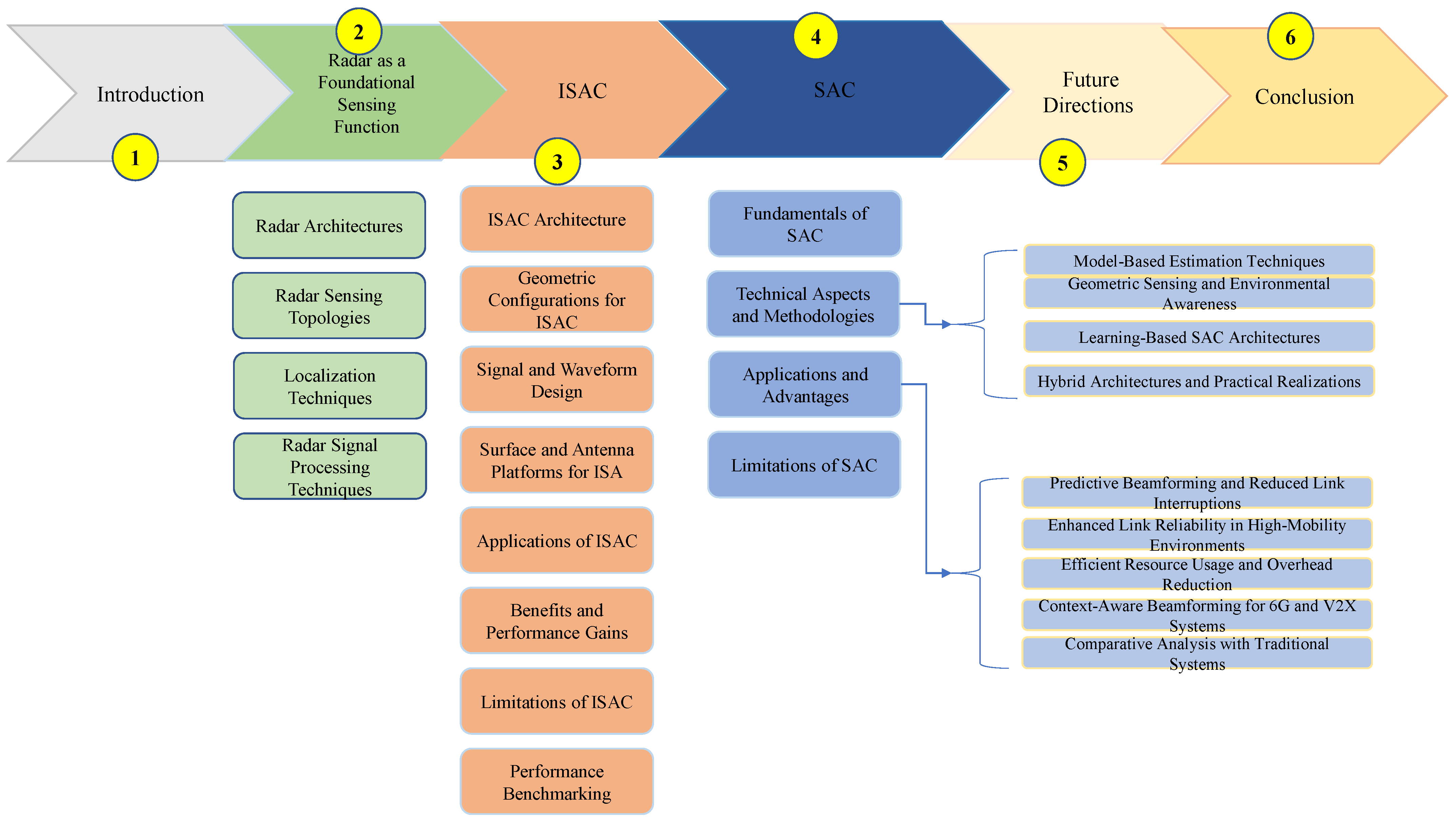
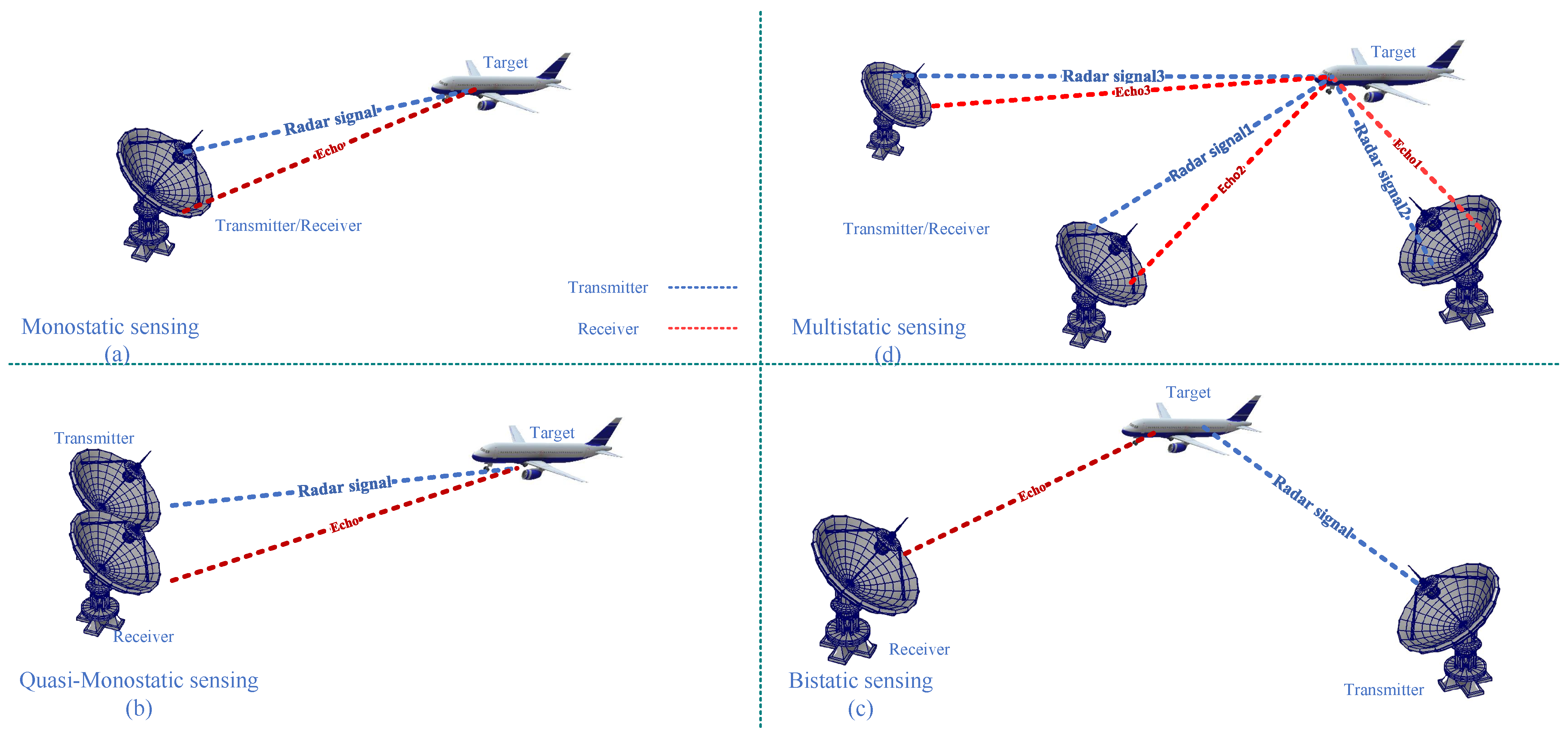
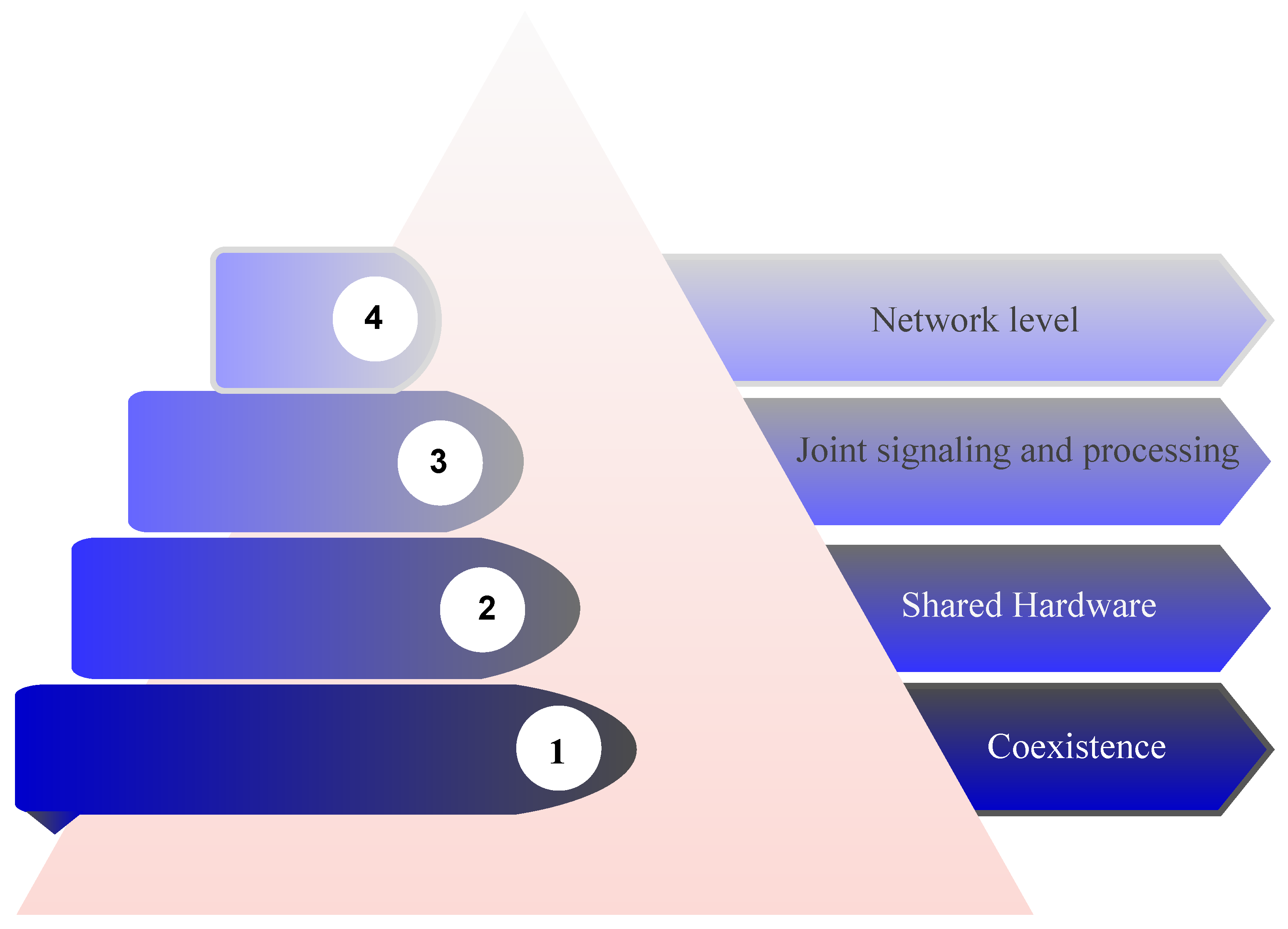
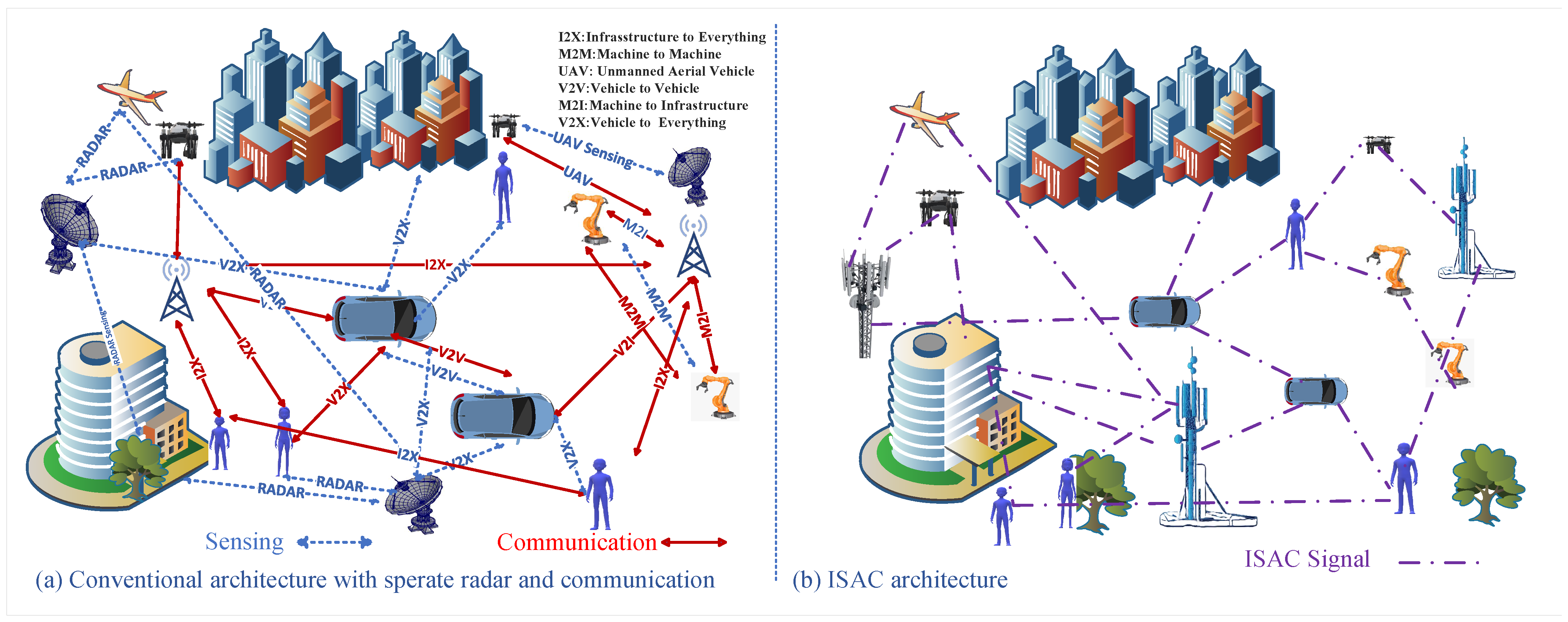
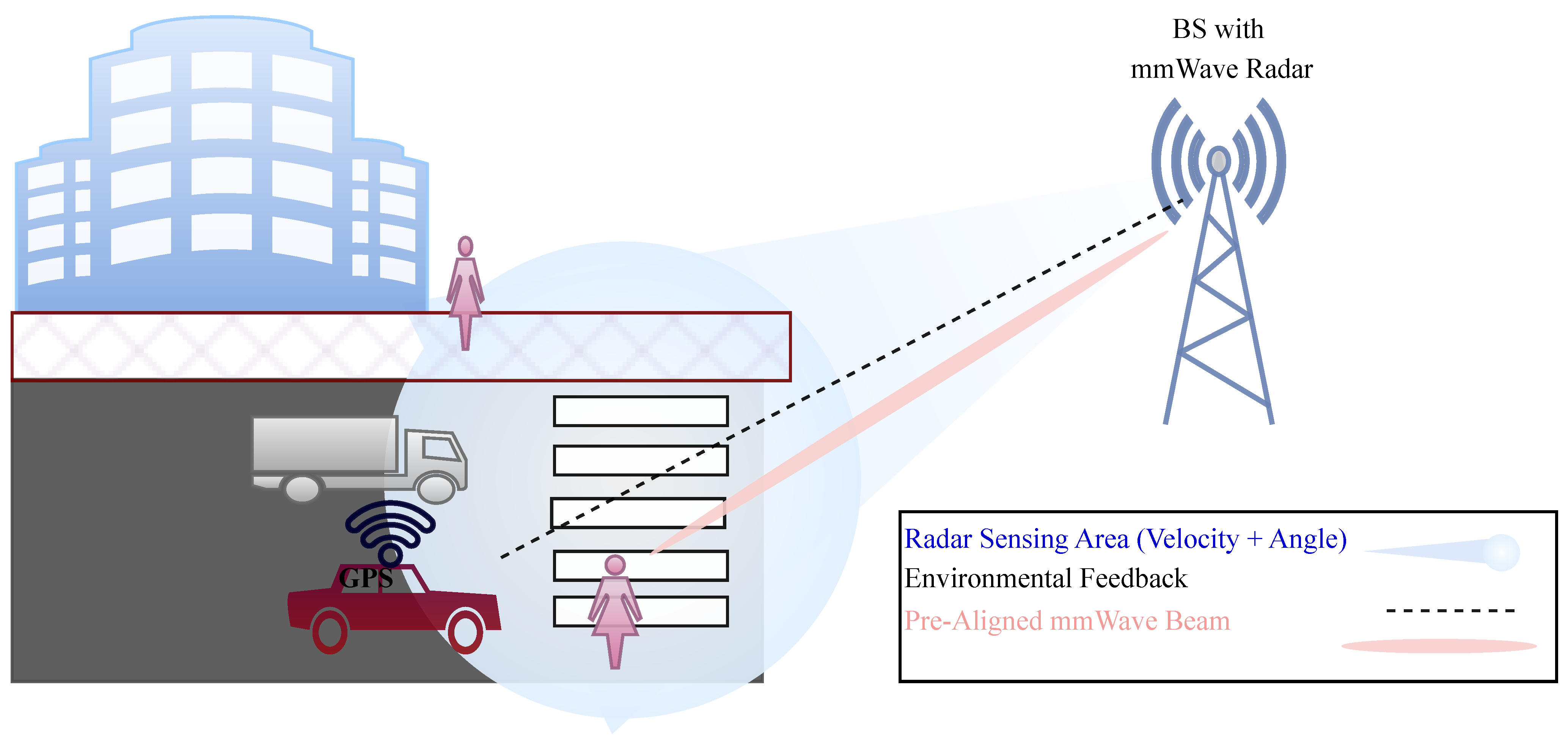
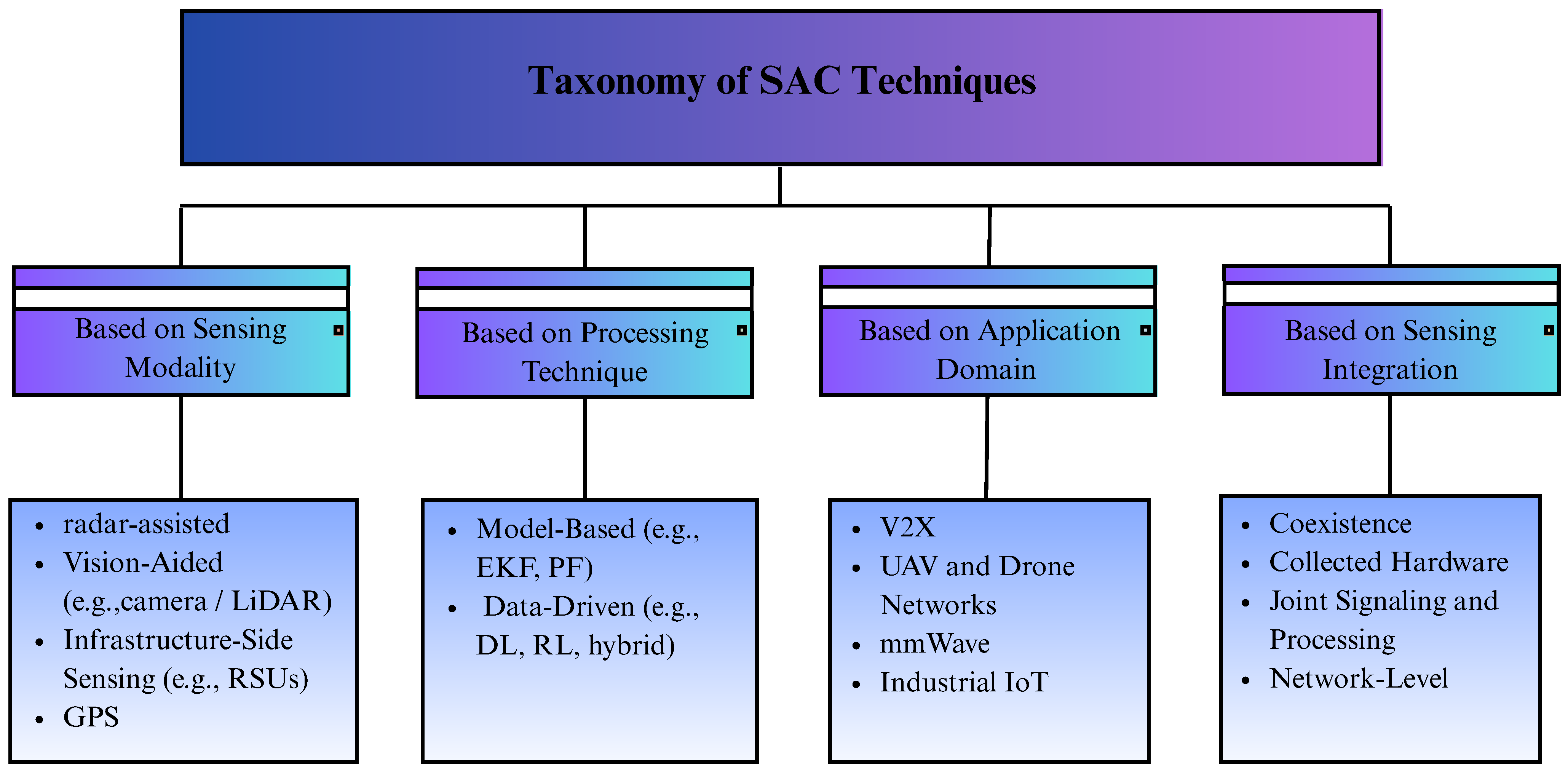
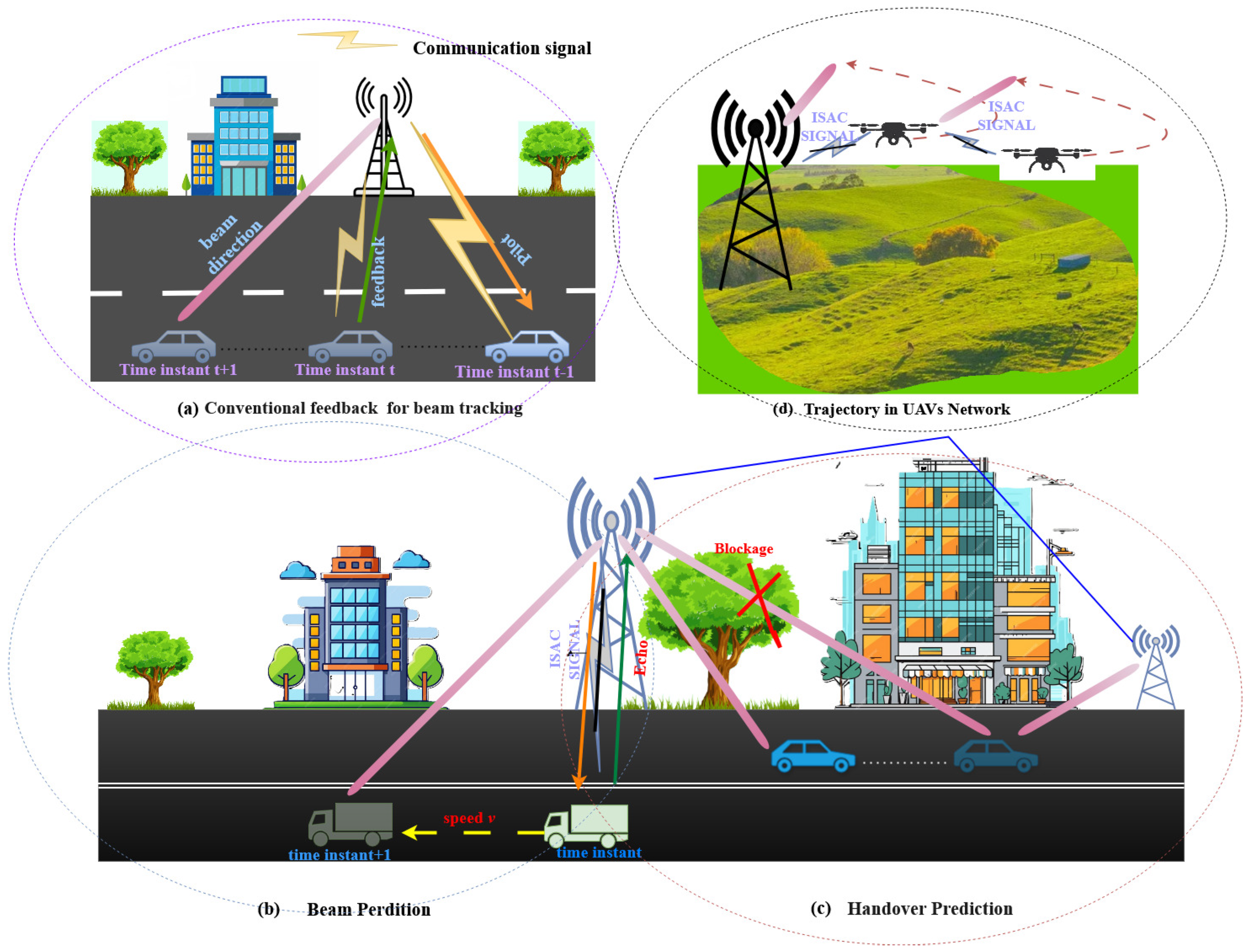
| Paper | ISAC Focus | SAC-Specific | Taxonomy | Application Domains | Beamforming Integration |
|---|---|---|---|---|---|
| [1] | ✓ | ✓ | Partial | Broad (6G) | No |
| [2] | ✓ | ✕ | No | General ISAC | No |
| [5] | ✕ | ✓ | No | V2X vehicular only | Partial |
| [10] | ✕ | ✓ | No | V2X, radar-centric | Yes |
| [6] | ✓ | ✓ | No | Beam alignment in mmWave | Partial |
| This review | ✓ | ✓ | SAC-focused | V2X, UAV, Indoor mmWave | Core to SAC |
| Configuration | Tx/Rx Arrangement | Advantages | Challenges |
|---|---|---|---|
| Monostatic | Co-located transmitter and receiver | Simplified design; strong echoes; mature technology [2,17] | Limited angular diversity; easier to detect [17] |
| Quasi-monostatic | Slight Tx/Rx separation within a common node | Better angular resolution; simple synchronization [26] | Less diversity than bistatic; moderate added complexity [26] |
| Bistatic | Spatially separated Tx and Rx | Covert reception; geometric diversity; stealth detection [27] | Requires synchronization and waveform knowledge [27] |
| Multistatic | Distributed Tx/Rx nodes with overlapping coverage | Robust detection; spatial diversity; cooperative sensing [28,30,31] | High coordination and data fusion overhead [29,31] |
| Ref | Technique | Applicable Topologies | Advantages | Challenges |
|---|---|---|---|---|
| [36] | AoA | Monostatic, MIMO, Multistatic | High angular resolution with large arrays; aligned with MIMO architectures | Sensitive to calibration errors and multipath |
| [36] | ToA | Bistatic, Multistatic | Direct range estimation; high accuracy with wideband signals | Requires tight synchronization; prone to NLoS bias |
| [37] | TDoA | Bistatic, Multistatic | Eliminates clock bias; robust with distributed receivers | High synchronization and coordination complexity |
| [32] | RSSI | Monostatic, Bistatic | Simple, low-cost, no extra synchronization | Poor accuracy; vulnerable to fading and blockage |
| [34,36] | Hybrid (AoA+TDoA, AoA+RSSI) | Multistatic | Combines complementary modalities; robust under NLoS and mobility | Higher computational burden; requires fusion algorithms |
| [38] | Multi-user Positioning & Beamforming | MIMO, Multistatic | Joint optimization of positioning and communication; enhances SAC beam alignment | Requires joint design of sensing and communication resources |
| Configuration | Synchronization Complexity | Spatial Coverage | Typical Use Cases |
|---|---|---|---|
| Monostatic | Low (self-synchronized) [2,45] | Local, directional [2] | Base station sensing, indoor localization, industrial robotics [2] |
| Bistatic | Medium (requires coordination) [46,47] | Moderate (dual-node coverage) [46,47] | V2X sensing, cooperative edge devices, stealth detection [46,47] |
| Multistatic | High (multi-node synchronization) [49,50] | Wide-area, multi-angle [49,50] | Smart city infrastructure, vehicular networks, environmental monitoring [49,50] |
| Waveform Design Strategy | Key Benefits | Challenges | Application Scenarios |
|---|---|---|---|
| OFDM-Based ISAC [46] | Enables dual-functionality in mmWave | High PAPR, sensitive to interference | Vehicular networks, 802.11ad/ay WLANs |
| LFM and Phase-Coded [47] | Strong radar accuracy, low sidelobes | Limited spectral efficiency | Short-range sensing, industrial IoT |
| Multi-Objective Design [49] | Balanced sensing and communication | Computational overhead, design complexity | Adaptive 6G base stations, smart factories |
| Adaptive Selection [50] | Flexibility under changing conditions | Requires feedback and control logic | UAV navigation, mission-driven sensing |
| Spectral Precoding [53] | Improved angular resolution | Needs accurate CSI and calibration | MIMO arrays, beam-aware ISAC |
| Application Domain | Latency Requirement | Sensing Resolution | ISAC Benefits |
|---|---|---|---|
| Automotive (V2X) | ≤10 ms | ≤0.1 m (range); ≤5° (angle) | NLOS detection; reduced hardware overhead; joint localization |
| UAV and aerial sensing | 10–50 ms | 0.5–1 m (range); ≤10° (angle) | GNSS-independent mapping; low-payload integration |
| Smart infrastructure | 50–100 ms | 1–2 m (range); medium angular resolution | Human detection; occupancy monitoring; gesture tracking |
| Defense and rescue | ≤20 ms | Environment-dependent | LPI communication; passive sensing; robust in degraded conditions |
| Feature | Traditional Systems | ISAC Approach |
|---|---|---|
| Spectrum Use | Dedicated to either sensing or communication | Shared spectrum for dual functionality |
| Hardware Architecture | Separate RF chains and baseband paths | Unified transceiver and baseband processing |
| Environmental Awareness | Absent or limited (feedback-based) | Continuous radar-based spatial awareness |
| Latency Handling | Reactive handovers | Proactive beam and resource adaptation |
| Cost and Energy Efficiency | High due to redundant components | Improved via reuse of spectrum and hardware |
| KPI Dimension | Indicative Values | Notes |
|---|---|---|
| Positioning accuracy | 1–10 cm; 0.5–1 m | High-precision vs. general scenarios |
| Velocity accuracy | 0.03–0.1 m/s | Resolution and range dependent |
| Range resolution | 0.1–1 m | Separation of close targets |
| Angle resolution/accuracy | 0.1°–1° | Antenna aperture dependent |
| Latency | 10–1000 ms | Sub-100 ms for critical cases |
| Update rate | 0.5–50 Hz | Slow vs. fast dynamics |
| Detection reliability | <1–5% errors | Confidence 95–99% |
| Availability | 90–99% | Environment and deployment dependent |
| Ref(s) | SAC Technique Category | Key Contribution(s) | Accuracy | Latency | Complexity |
|---|---|---|---|---|---|
| [35,76] | Model-based (EKF, PF) | EKF for beam tracking; PF for non-Gaussian mobility | EKF: Medium; PF: High | EKF: Low; PF: High | EKF: Low; PF: Medium |
| [58,77,78,79,80] | Geometric sensing | Radar/GPS/IMU beam prediction; sub-6 GHz out- of-band learning | Medium | Medium | Medium |
| [80,81] | Learning-based | Neural nets and RL for dynamic beam adaptation | High | Medium | High |
| [10] | Hybrid architectures | Fusion of radar, EKF/PF, and deep learning | High | Medium | High |
| [58] | Application-domains | V2X, UAV and IoT | V2X: High; UAV: Medium; IoT: Low | V2X: High; UAV: Medium; IoT: Low | Domain-dependent |
| [10,58] | Integration levels | From coexistence to fully integrated ISAC | High | Medium | High |
| Performance Metric | Traditional Systems | SAC-Enabled Systems |
|---|---|---|
| Beam Training Overhead | High (exhaustive/codebook search) | Low (sensing-guided prediction) |
| Beam Alignment Latency | Reactive (100–200 ms typical) | Proactive (10–50 ms with prediction) |
| Accuracy of Beam Tracking | Moderate (reliant on CSI quality) | High (enhanced by environmental sensing) |
| Robustness to Mobility | Limited (frequent re-alignment needed) | High (trajectory-aware beam control) |
| Spectral Efficiency | Lower (frequent training consumes slots) | Higher (more slots available for data) |
| Energy Efficiency | Lower (redundant scans, retries) | Higher (fewer re-transmissions) |
| Latency in Handover | Reactive, delay-prone | Anticipatory, low-latency |
| Adaptability to Dynamics | Low (based on past CSI) | High (real-time environmental awareness) |
Disclaimer/Publisher’s Note: The statements, opinions and data contained in all publications are solely those of the individual author(s) and contributor(s) and not of MDPI and/or the editor(s). MDPI and/or the editor(s) disclaim responsibility for any injury to people or property resulting from any ideas, methods, instructions or products referred to in the content. |
© 2025 by the authors. Licensee MDPI, Basel, Switzerland. This article is an open access article distributed under the terms and conditions of the Creative Commons Attribution (CC BY) license (https://creativecommons.org/licenses/by/4.0/).
Share and Cite
Mahmoud, R.; Castanheira, D.; Silva, A.; Gameiro, A. Sensing-Assisted Communication for mmWave Networks: A Review of Techniques, Applications, and Future Directions. Electronics 2025, 14, 3787. https://doi.org/10.3390/electronics14193787
Mahmoud R, Castanheira D, Silva A, Gameiro A. Sensing-Assisted Communication for mmWave Networks: A Review of Techniques, Applications, and Future Directions. Electronics. 2025; 14(19):3787. https://doi.org/10.3390/electronics14193787
Chicago/Turabian StyleMahmoud, Ruba, Daniel Castanheira, Adão Silva, and Atílio Gameiro. 2025. "Sensing-Assisted Communication for mmWave Networks: A Review of Techniques, Applications, and Future Directions" Electronics 14, no. 19: 3787. https://doi.org/10.3390/electronics14193787
APA StyleMahmoud, R., Castanheira, D., Silva, A., & Gameiro, A. (2025). Sensing-Assisted Communication for mmWave Networks: A Review of Techniques, Applications, and Future Directions. Electronics, 14(19), 3787. https://doi.org/10.3390/electronics14193787









